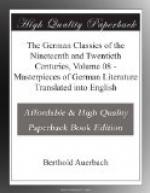In the same way that people had their portraits executed by the engraver, they also liked to depict their own likeness in their letters, diaries, and memoirs. The custom came to us from the French in the seventeenth century, and, as a real child of the Rococo, triumphantly survived the struggle with the Pigtail, and lasted on into the nineteenth century. No man nowadays can carry on such extensive friendly correspondence as was universally carried on from fifty to a hundred years ago. This self-inspection, this importance attached to little personalities, disgusts us. The letters of Gleim, Heinse, Jacobi, Johannes Mueller suffice to make us feel fully conscious of this disgust. We should now call the man a coxcomb who considered his precious ego so important that he had to carry on, year in and year out, a yard-long correspondence about himself. General interests have grown, private interests have shriveled up, but thereby, indeed, the original types of the old days have become impossible.
That strange union of charlatanism and science, of prognosticating mysticism and sharp-eyed observation which in the Renaissance had, as it were, become incorporated in large learned guilds, such as the astrologers, alchemists, theosophists, etc., dies away in the Rococo period in isolated strange individuals. Mesmer, Lavater, Athanasius Kircher, Cagliostro are such Rococo figures in the very midst of the Pigtail. Professor Beireis, in Helmstaedt, who in the eighteenth century still tried his hand at making gold, carried on an incredible jugglery with his collection of curios and made his enlightened contemporaries believe that he possessed a diamond weighing six thousand four hundred carats, which the Emperor of China had pawned with him, would, in former times, if he had not been duly burned as a magician, have become the head of a school. In the eighteenth century he merely remained a mysterious eccentric type whose gaudy collection was gazed upon with astonishment by all travelers, half charlatan, half savant—in any case, however, a marvelous virtuoso of personality. In our day even such an isolated original type would no longer be possible at all. It is thoroughly Rococo.
The Middle Ages had had its guild secrets. In the period of the Rococo a trading in secrets by individual scholars and artists had grown out of it. Among the painters and musicians especially, even the smallest master carried on his particular legerdemain with the “secrets” of art, which he alone ostensibly possessed and communicated only to his pupils.
The profession of court fool had died out. In its place the individual geniuses of folly appeared in the Rococo age, such as Gundeling, the passive clown, who was made a fool of by others, and Kyau, the Eulenspiegel of the eighteenth century, who himself hoaxed other people. In the learned Athanasius Kircher the charlatan of genius struggles continually with the pedant; that is the great struggle which continued




